That's what I would have liked to experience: a P5M Marlin taking off!
The Martin P5M Marlin
It must have been a breathtaking experience when a thirty-metre-long flying boat, like this Martin P5M Marlin, made the water spray under the roar of its 3500 hp Wright 3350 engines running at full power to get the 36 000 kilos of maximum take-off weight into the air. With a cruising speed of 240 Km/h, the Marlin patrolled with a range of 3300 kilometres, a good 400 Km/h was to be expected as top speed. 11 crew members were usually necessary to perform the tasks for which this giant flying boat had been created.
Sea surveillance and submarine hunting was the métier in which the Martin PM5 Marlin excelled. The design directly continued a success story that had been started with Martin's PBM Mariner a good 15 years earlier. At that time, the Glenn L. Martin Company could draw on a tradition of building seaplanes that dated back to the year the company was founded. From 1940, the PBM Mariner was put into series production on behalf of the US Navy. A total of 1285 examples of this large flying boat were produced between 1940 and 1949; a testament to the performance and excellent reputation that this type was able to acquire during its long career in the war years and the time of the outbreak of the Cold War.
The design of the new Martin Marlin model was intended to improve on the solid basic design of the Mariner and to exploit the potential that still lay within it. Accordingly, the first prototypes closely followed the design of the initial design. However, right from the start, two Wright R-3350 radial engines, still one of the most powerful piston engines ever built, lifted the available power into a new class.
In the course of testing the prototype XPBM-1, which was flown for the first time in 1948, changes were constantly incorporated, so that the outer shape also moved further and further away from the model of the Mariner. A T-tail became standard, and the shape of the hull in the bow area had to be redesigned to optimise seaworthiness. Interestingly enough, the model of the powerful Japanese flying boat H8K "Emily" had provided the impetus for this.
By the time the final production versions appeared, the PBM Marlin had also lost the weapon stands at the bow, centre of the hull and stern that had initially still been fitted. Instead of the foremost weapon turret, the AN/APS-4 search radar was installed, whose semi-circular fairing pulled forward was to determine the Marlin's appearance. In the stern, too, there was no longer a turret; instead, domes were installed for visual observation. Incidentally, the elongated tube with a semi-circular end at the extreme stern end is not a radar dome, but a particularly spectacular observation post: the crew member had to crawl into this tube and then, lying on his stomach, watch the sea through a downward-facing window!
The five disc-shaped detectors of the MAD system were located on the tail boom, which extended far beyond the end of the fuselage. This enabled the position of submerged submarines to be determined, the combating of which was part of the Marlin's operational spectrum.
In keeping with the tradition of its predecessor, the Martin Mariner, the load of weapons to be dropped was carried in the compartments behind the engine cowlings. The weight of this deadly cargo of mines, depth charges or torpedoes was considerable: up to 3,600 kilograms were loaded internally, and another three and a half tons could be attached externally to underwing stations.
The P5M Marlin was in service with the US Navy and the US Coast Guard. Their seven aircraft were returned to the Navy after a short time, however, as maintenance and the procurement of spare parts proved to be too costly for the Coast Guard compared to their operational value. This came just in time for the Navy: a separate training unit for prospective Marlin crews was equipped with the unarmed Marlins. The only other owner was to be the French Navy, to which eleven examples of this large flying boat were delivered between 1957 and 1959. These were subsequently deployed from Dakar in West Africa, but were also sold again by 1964.
The Martin P5M Marlin, BuNo 135505, which I have used as a model here, was flown by the "Maritime Patrol Squadron" VP-45 at the end of the fifties/beginning of the sixties. This unit, originally based in Florida, had a turbulent history and was deployed to a number of theatres during the escalating Cold War in those years. In May 1962, the Marlin shown here was part of "Task Group Delta", in the context of which new tactical procedures for naval warfare were tested. A little later, in October 1962, the aircraft of VP-45 took part in the confusing and fire-dangerous operations surrounding the so-called Cuban Missile Crisis. Never before had the world been so close to the outbreak of nuclear war.
In January 1964, the VP-45 made history once again: it was the last unit of the Atlantic Fleet to give up its flying boats; from now on, all Maritime Patrol Squadrons of the US Navy were equipped exclusively with land-based aircraft, and the time of the spectacular flying boats was finally over.
About the kit and the building process
The kit of the Marlin dates from 1971 and corresponds in every way to the high standard of the time, which Hasegawa played a major role in formulating. In light of this, it is of course not surprising that the cockpit and interiors are completely or as good as empty and the detailing of the engines seems meagre by today's standards. On the other hand, the modeller can expect a sensible parts layout and the best fitting accuracy.
The construction itself therefore went quickly and the energy saved in this way could be invested in post-detailing and refinement. The cockpit interior was completely rebuilt with the help of etched parts, harnesses, pilot seats etc. from the fundus, the engines gained new life with a little attention in the form of ignition cables.
A little thought was required to make the circular MAD detectors on the tail boom. These were not included in my kit - and had they been, they would certainly have been too crude - and so had to be made myself. My solution was to drill suitable holes in a polysterol plate and then cut the surrounding material with feeling so that the desired rings were created. This method actually worked so well straight away that I can recommend it to any modeller who faces the same challenge.
By the way, the markings for this particular machine are from Caracal. This decal sheet is not only recommended because of the range of interesting marlins and the high quality as well as best workability of the decals, but also for the simple reason that the decals of the kit dating from the grey past are unlikely to be used any more.
One topic with "flying aircraft models" is naturally the crew in the cockpit. Here, I have made two suitable figures from "PJ Production" so that they can pass as pilot and co of a seaplane of the 60s. In addition to a matching moustache, they also have a headset with a headband and a microphone made of wire strands.
The issue of a flying representation is exacerbated by the need to achieve rotating propellers. Here I was able to draw on the experience that I have gained in the representation of several "moving" models. The question of how this method would look in 1/72nd scale was particularly exciting for me; up to now I have only tried rotating propellers on models in 1/48th scale or larger.
A really big issue with a starting flying boat is the representation of the water around a taking off flying boat. The pictures of the building phase show the main steps: on the wooden back wall of a picture frame I used clay to lay the base of the waves as well as the splashing area around the flying boat resting on two pegs. The individual waves were imprinted into the clay with the fingertips in such a way that the wind direction would be at right angles to the longitudinal axis of the launching flying boat.
Before the clay was completely dry, the colour of the water was determined with several shades of blue and green, after which the excellent "transparent water gel" from AK could be applied. Then--and again before the gel was completely dry--the spray combs of individual wave peaks were created with acrylic paint. In a final step, the finished model of the marlin was placed and the white water was applied with commercially available cotton wool. For me, this was not only essentially the completion of the water representation but also a particularly pleasurable act!
Finally, and to close the arc, may I say that I am pleased to be able to pay homage to the aforementioned drama and spectacular appearance of a large flying boat with this depiction of a P5M Marlin taking off. After all, this is a sight that can no longer be experienced today!
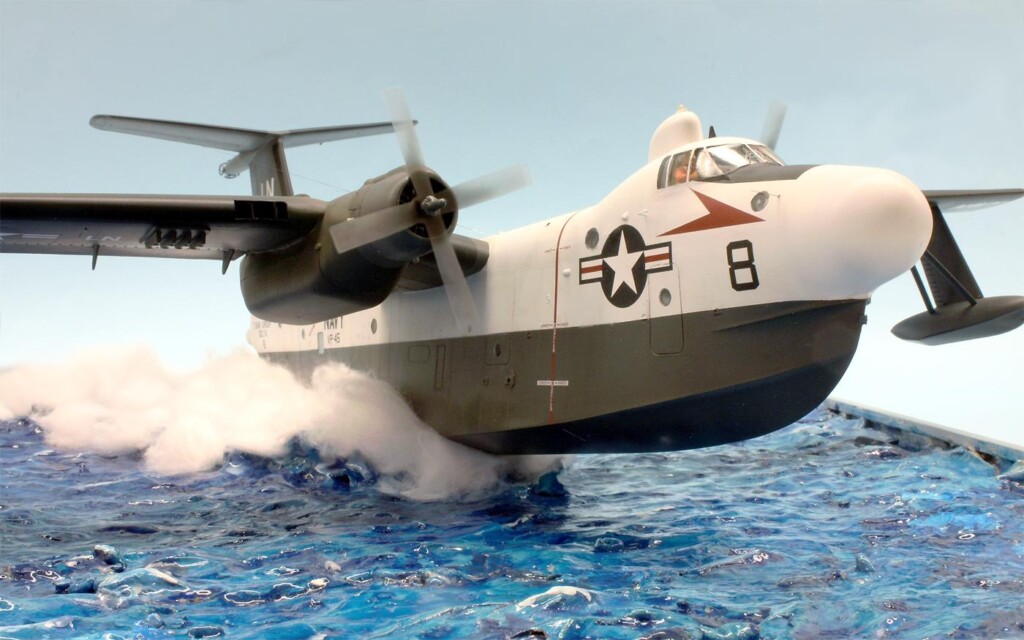
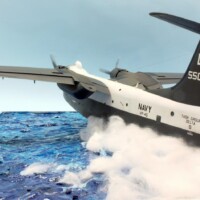

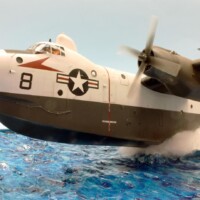
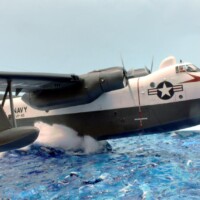
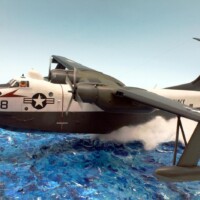
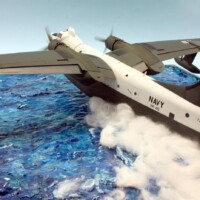
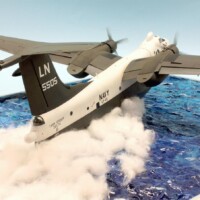
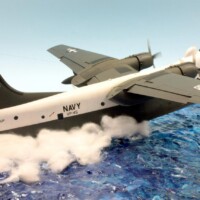
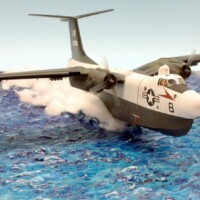
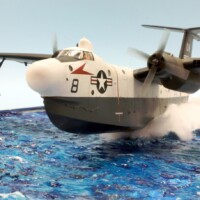
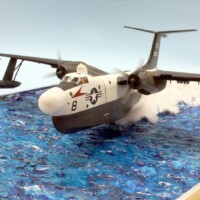
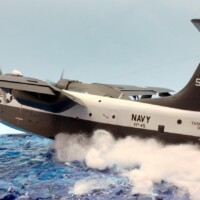
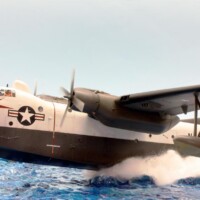
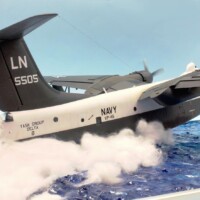
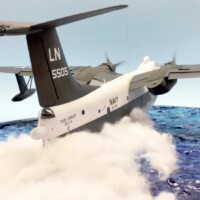
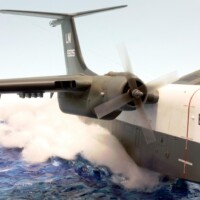
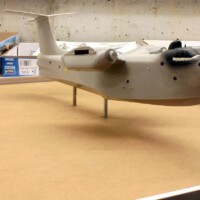
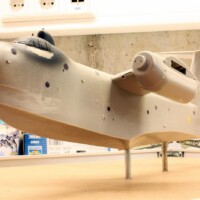
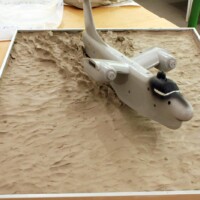
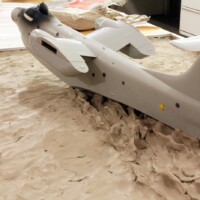
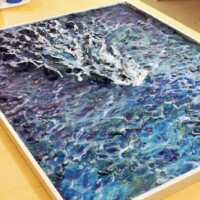
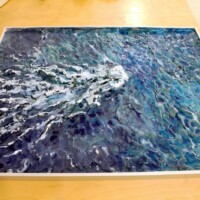
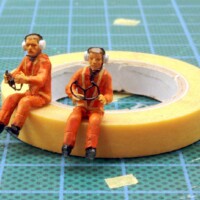
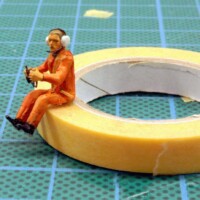
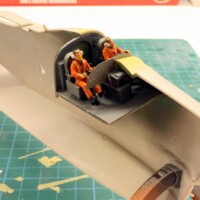
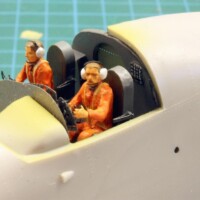
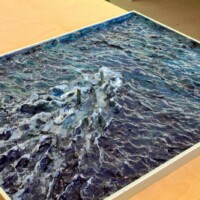
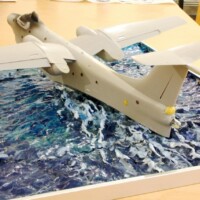
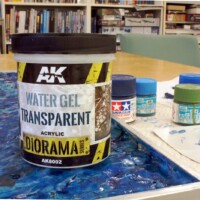
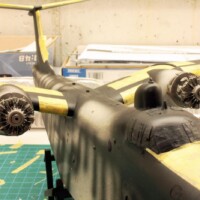
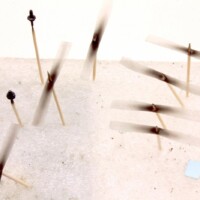
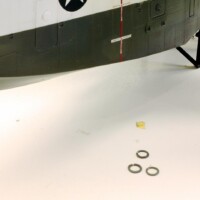
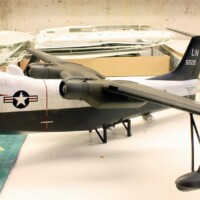
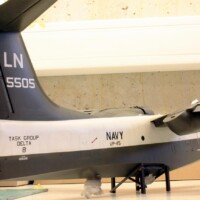
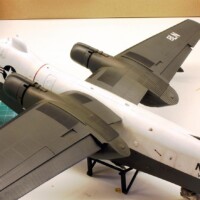
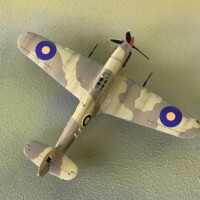
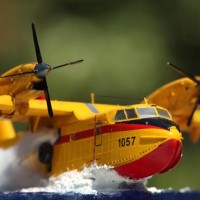
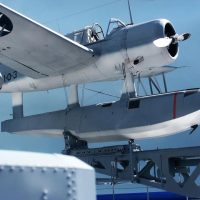
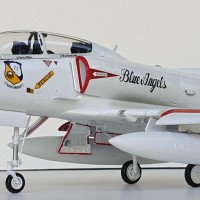
The water base is excellent, and I like what you did with the props!
Thank you for your words, Jeff!
Fantastic work, Roland (@rosachsenhofer). This is the kind of diorama I dream about building but can never execute. I can't imagine how long this took to build. Well done!
Thank you very much!
To be honest and to my own surprise, it wasn't that long. According to my notes on "Scalemates", I started on 20 July and was able to complete the work on 19 August.
Loved your write-up as always, Roland, making the MAD detectors with “feeling” is just great. I think if you were ever lucky enough to watch one of these monsters taking off then the instructions “stand well back” would be apt. Thanks again for yet another terrific post, just the right amount of history and build details without plugging your “bookazine”.
Your words bring me great joy - and encourage and motivate me Thank you for this feedback!
Thank you for this feedback!
Fantastic diorama, Roland @rosachsenhofer
Everything about it looks very realistic, the water, the spray, superb.
Thanks for the supporting article as well, great written.
John, I say thank you very much!
SPECTACULAR! Well done, Roland.
Thank you very much - I'm glad to hear it!
Very nice write up and model/diorama work. Truly impressive.
Thanks for all the detail sharing on the build.
Thank you Bernard, your words are much appreciated!
Very impressive work Roland! That looks quite convincing to me, and as usual, I really enjoyed the historical background. Keep 'em coming @rosachsenhofer!
That looks quite convincing to me, and as usual, I really enjoyed the historical background. Keep 'em coming @rosachsenhofer! 
I can only say thank you! That makes me happy!
Congratulations Roland! A wonderful result, truly realistic! Amazing article, as well!
Thank you Spiros, my friend! Your words are motivation for me!
This is Air Museum quality. Thanks for posting this amazing article, and the in-progress steps. Very informative.
Thank you very much! I am glad that the contribution is so well received!
Roland, I've never seen such an airplane take off, but you have "sold" the conceit so perfectly, mostly in my eye by creating a convincing angle of the moment of separation. Yours is an absolutely astounding diorama. Congratulations!
Christopher, thank you for this great recognition!
Roland - @rosachsenhofer - let me say this is the most spectacular Pigboat model I have ever seen. Those who used the words "museum quality" are right. This is easily one of your best creations ever.
As the only Pigboat sailor here, can I correct a few things in your description and share some memories of "Seashell 5" of VP-40, which I spent some time in cadging flights?
Takeoff in a Pigboat was mostly a lot of shaking, shimmying, bouncing, becoming less and less, and then there was none and she had once again defied the laws of aerodynamics and gotten airborne. Once in the air and trimmed up, she was very light on the controls (everybody got to fly the airplane for awhile on every mission).
One thing - she couldn't do that defiance of aerodynamics without four JATO bottles hung aft of the rear hatches. Not unless she was at about 2/3 gross takeoff weight. If you could have figured a way to do those, this spectacular diorama would be even moreso.
Once airborne, those R-3350s were only about 8 feet to either side and there was no soundproofing, so you wore your brain bucket the whole time so you could communicate with the guy next to you over the intercom. I suspect those hours and the time spent backstage with the sexanddrugsandrockandroll when I worked at Rolling Stone are why I have the hearing loss I do today.
The only thing in the tail was the old gunner's position, which was as far away from the engines as you could get, and everybody took breaks back there to get away from the noise. That clear piece below is not an observation post, but rather Hasegawa's take on the tip of the MAD boom that could be extended for sub hunting. All the defensive armament and the armor plate and such was removed over the years to use the allowable weight for more electronic gear.
If she ever did more than 200mph, I am sure she would have shaken herself to death.
As to operations, the last squadron using P-5s was VP-40, which gave up the last one in the fall of 1966, after operating from Cam Ranh Bay on forward ops since the (alleged) Tonkin Gulf (non) Incident on Operation Market Garden, chasing "VC Gunrunners" who never showed up and always turned out to be local fishermen who "crossed the lines" without knowing they were in an identification area. (to give credit where credit is due, there were two "gun runners" spotted off Cap St. Jacques that came from Cambodia in 1965)
Before Vietnam, the P-5s generally operated off the coast of China from Shantung to Hainan Island on "ELINT" ops, flying either from Buckner Bay Okinawa from the seaplane tender, or from their main base at NAS Sangley Point in Manila Bay. The idea was the US recognized the 3-mile limit, the Chinese claimed 12 miles, and the P-5s split the difference around 8 miles - where they could skedaddle back over the 12 line if Thunderbolt Control told them the PLAAF had anything airborne in the vicinity. There were times cruising above the cloud deck that you'd find a hole and when you looked down you saw brown and green instead of blue, which mean't a quick turn east get her up to those 200 kts.
The most interesting Pigboat op was when USS Pine Island (aka "the old USS Rustbucket") went to the Galapagos Islands in January-February 1964 to support the first major scientific expedition there since Darwin showed up on the Beagle. We actually met the tortoise that met Darwin, with the "1835" carved in its shell. That was back before the islands got overpopulated and the @#$#@! cruise ships arrived to dump their garbage. It was quite an adventure.
Anyway, beautiful model even without the JATO. Thanks for the reminder.
Hello Tom, what words should I find for these comment? I am delighted, honoured and deeply impressed.
Your explanations are incredibly associative, creating images in the imagination that you let one fly with. One recognises and enjoys the profound author.
What is impressive is the fact that you were actually there and can describe at first hand what I have to make up from books.
What you write is really informative - I will incorporate your corrections in the further use of this text. Thank you for the inspiring conversation, the new and welcome insights and your words of appreciation!
Absolutely outstanding, Roland. You’ve outdone yourself with this one.
Thank you very much, your words make me very happy!
Major league coolness on display here...
Thank you David!
Nicely done Roland.
Appreciated! Thank you Allen!
Roland, very well done. Always liked the look of the Marlin -ugly is as ugly does as was said when I was in the Navy. However, I was in after Vietnam.
Thanks alot Steve!
I lack words to say how impressed I am.
I can only say thank you - I feel motivated!
No, you motivated me! so much so that I had to to get this kit - which now has arrived! It will be a good companion for my other two 1/72 USN patrol planes (a Privateer and a Neptune).
spectacular!
Thank you!
All of the above! Beautiful work!
Thank you very much, Robert!
Roland, I am speachless by this fine peace of art...
A motivating feedback, thank you Georg!
Excellent flying boat diorama!
Thank you Dan!
A beauty of a diorama! Love it.
Greg, I am very pleased with your words!